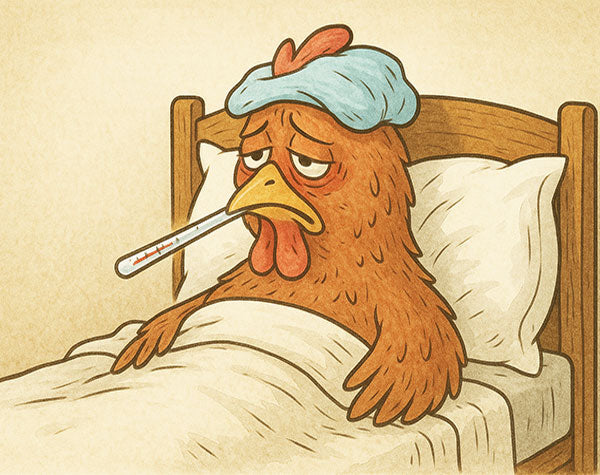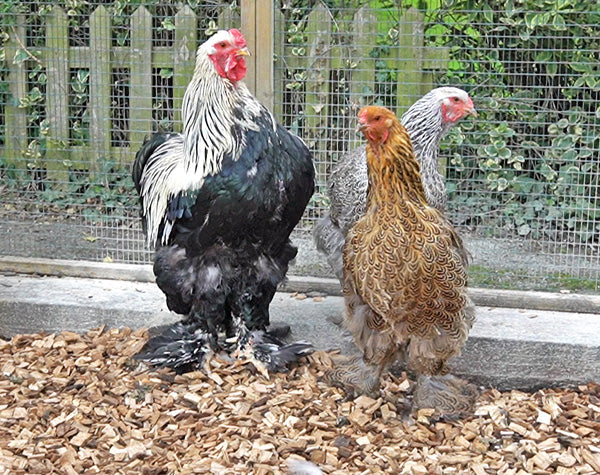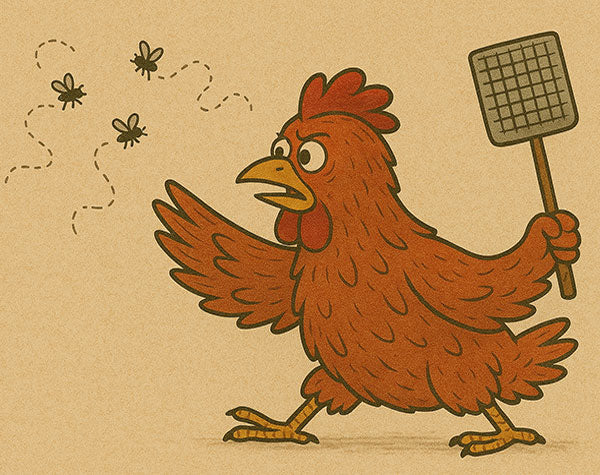🐓 Chicken Health Compendium
This page covers: Bacterial & Viral Infections
Part of our Chicken Health Hub - a guide to identifying, preventing, and treating common poultry health issues.
Chickens are just as likely as we are to pick up infections from the world around them. A bacterial infection might be fought off, but it can leave a bird feeling run-down - like we feel after the flu - and having it once doesn’t guarantee it won’t come back.
Viral infections can sometimes bring lasting immunity, which is great … unless a bird passes it around the flock first, like a sneeze in a lift.
You’ll notice that many of the preventions below all point to the same few habits: good hygiene, regular cleaning, and keeping their housing dry and fresh. It’s hardly the glamorous side of chicken keeping, but it’s one of the most important - a bit of disinfecting today could save you a vet's bill tomorrow.
In this section: Newcastle Disease · Marek’s Disease · Avian Influenza · Mycoplasma · Infectious Bronchitis · Salmonella · E. coli · Botulism · Vent Gleet · Sour Crop · Heart Disease
Note: Wry Neck (Torticollis) can sometimes be a symptom of other infections such as Marek’s or Newcastle disease. See the full entry under Physical & Environmental Issues.
Newcastle Disease (Fowl Pest)
A serious and often fatal viral disease affecting the respiratory, nervous, and digestive systems. The UK is largely free of it, so it’s very rare in backyard flocks. Because it is zoonotic (can be transmitted to humans), it is a notifiable disease - by law you must inform DEFRA/APHA if suspected.
Symptoms
- Twisted necks, tremors, paralysis (torticollis)
- Green diarrhoea
- Sudden drop in egg production
- Sneezing and coughing
Prevention
- Strict biosecurity
- Vaccination (more common in commercial flocks)
- Quarantine new birds
Treatment
- No cure — often fatal
- Vaccines are used to control outbreaks
- Infected birds are culled
- Notify APHA immediately if suspected
Marek’s Disease
A viral disease (herpes virus) leading to tumours and paralysis. Spread by inhalation of infected feather dander. Some breeds (e.g. Silkies, Sebrights) are more susceptible; reputable breeders vaccinate chicks.
Symptoms
- Lameness or paralysis (legs/wings)
- Weight loss despite normal appetite
- Grey or irregular pupils
- Tumours, disorientation, twisted neck (torticollis)
Prevention
- Vaccinate chicks at 1 day old (and per breeder protocol)
- Keep brooders/housing clean (e.g. Virkon S)
- Avoid mixing vaccinated and unvaccinated birds
Treatment
- No cure; antibiotics only address secondary infections
- Supportive care only; prognosis poor
- Culling often recommended
Avian Influenza (Bird Flu)
A serious, highly contagious viral disease; certain strains (e.g. H5N1) are notifiable and often lethal. Registering your flock with APHA helps ensure you receive official outbreak guidance. Find out more about Registering your Flock and Hints & Tips about Bird Flu.
Symptoms
- Sudden death
- Swollen head, blue/purple comb
- Coughing, diarrhoea
- Nervous signs (tremors, incoordination)
Prevention
- Follow DEFRA guidance during outbreaks
- House birds under cover when ordered
- Limit contact with wild birds
Treatment
- No cure
- Euthanasia is required in confirmed cases
- Report suspected cases to APHA immediately
Mycoplasma (Mycoplasma gallisepticum)
A highly contagious respiratory bacterial infection affecting sinuses, airways, and lungs. M. synoviae affects joints. Isolate suspects immediately.
Symptoms
- Sneezing, coughing, nasal discharge
- Swollen eyes or sinuses
- Decreased egg production
- Rattly breathing
Prevention
- Quarantine new birds
- Good coop hygiene and ventilation
- Prevent wild bird contact
- Avoid overcrowding
Treatment
- Vet-prescribed antibiotics (e.g. tylosin)
- Isolate affected birds
- Gently clean eyes; supportive vitamins/tonics e.g. Oreganico
- Recovered birds remain carriers
Infectious Bronchitis
A highly contagious viral respiratory disease affecting the kidneys, respiratory and reproductive tracts. Can resemble Mycoplasma or Newcastle Disease - proper diagnosis matters.
Symptoms
- Sneezing, coughing, watery eyes, gasping, nasal discharge
- Drop in egg production; misshapen or poor-quality shells
- Watery droppings
Prevention
- Early vaccination (per vet/breeder schedule)
- Biosecurity: disinfect boots/equipment; limit visitors
- Quarantine new birds
Treatment
- No cure; antibiotics only for secondary infections
- Warmth, low stress, good hydration and nutrition
Salmonella
Bacterial infection; several types are zoonotic (can pass to humans) via eggs or poor hygiene. Commercial and reputable breeder flocks are typically vaccinated.
Symptoms
- Diarrhoea
- Lethargy, poor appetite
- Sudden death in chicks
- Drooping wings, ruffled feathers
Prevention
- Coop hygiene; disinfect (e.g. Virkon S)
- Disinfect hatching eggs and incubators
- Control rodents; avoid wild bird contamination
- Clean feeders and drinkers regularly
- Buy vaccinated stock
Treatment
- Vet-prescribed antibiotics
- Isolate infected birds; they may remain carriers
- Reportable under UK law if confirmed in flocks
E. coli (Colibacillosis)
Common bacterial infection, often secondary to other illnesses (e.g. respiratory disease). Some strains show antibiotic resistance.
Symptoms
- Fluffed feathers, lethargy
- Poor growth in chicks
- Sudden death in chicks
- Diarrhoea
Prevention
- Good hygiene (disinfect regularly) and ventilation
- Keep bedding dry; reduce dust/ammonia
- Avoid stress and overcrowding
Treatment
- Vet-prescribed antibiotics
- Isolate affected birds; supportive care
Botulism
Rare but deadly poisoning from toxins produced in rotting organic matter (e.g. carcasses/spoiled feed/rotten vegetables). Prevent access to compost/rot. See our guide on What to Avoid Feeding to Chickens.
Symptoms
- Floppy neck (“limberneck”)
- Ascending paralysis (legs → wings → breathing)
- Drooping wings, difficulty breathing
Prevention
- Do not feed rotting meat or vegetables
- Remove carcasses/rotting material promptly
- No access to stagnant water or spoiled feed
- Keep litter dry; control flies
Treatment
- Antitoxin from a vet (rarely available)
- Flush crop with Epsom Salts under vet guidance
- Supportive care; prognosis poor in severe cases
Vent Gleet (Cloacitis)
Yeast (Candida) imbalance affecting the gut and therefore the vent area (like Thrush); can follow stress or other infections (e.g. sour crop). Find more details and video here: Chickens with a Messy Bottom.
Symptoms
- Swollen, red or yellow vent
- Foul-smelling white discharge
- Feather loss around vent; dirty bottom
Prevention
- Keep vent area clean and dry
- Balanced diet; probiotics as needed
- Avoid excessive kitchen scraps/vegetables
- Avoid overuse of antibiotics
Treatment
- Bathe/clean vent area
- Apply antifungal cream (e.g. Canestan)
- Probiotics or plain live yoghurt
- Apple Cider Vinegar (in clean drinking water)
Sour Crop
Fungal (yeast) infection in the crop, often after an impacted crop or antibiotic use. Can be serious if not treated promptly.
Symptoms
- Squishy, sour-smelling crop
- Bad breath
- Lethargy, poor appetite
- Crop doesn’t empty overnight
Prevention
- Prevent an impacted crop
- Probiotics after antibiotics
- Apple Cider Vinegar in clean water (about 10 ml per litre)
Treatment
- Withhold food; offer water with ACV or probiotics
- Gentle crop massage (do not induce vomiting unless trained)
- Vet may prescribe nystatin (antifungal); severe cases may need surgery
Heart Disease (Cardiac Issues)
A range of heart conditions, often linked to genetics, age, obesity, or rapid growth (more common in hybrids/broilers).
Symptoms
- Purple/blue comb or wattles (poor circulation)
- Lethargy; reluctance to move
- Rapid or laboured breathing
- Sudden collapse or death
Prevention
- Avoid high-calorie overfeeding
- Provide space for exercise
- Choose slower-growing/traditional breeds
- Disinfect hatching eggs/incubators if breeding
Treatment
- No cure; supportive care only
- Reduce stress and heat exposure
- Consult a vet for management
- - - - - -



